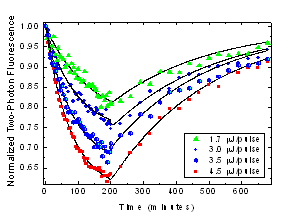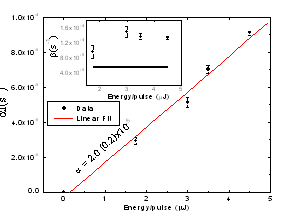Two-photon fluorescence measurements of reversible photodegradation in a dye-doped polymer
Ye Zhu, Juefei Zhou, and Mark G. Kuzyk
Department of Physics and Astronomy
Washington State University
Pullman, Washington 99164-2814
When an organic molecule is exposed to an intense laser beam, it degrades in the same way that vibrantly colored clothing fades over time when exposed to sunlight. This is a problem that has plagued many technologies, such as polymer displays and optical logic that could form the basis underlying next-generation computers. That’s why I was so excited when my students and I discovered molecules that heal when allowed to rest1.
To determine how strongly these molecules interact with light, we used two-photon fluorescence in solid samples made of polymer impregnated with dye molecules. Our laser is tuned so that when two-photons are simultaneously absorbed by a molecule, it glows a ghostly green when the molecules de-excite, betraying the two-photon absorption process. As is typical, it was observed that the green glow dimmed over time, suggesting that the sample was degrading. However, when the sample was left overnight in the dark, the molecules once again glowed like new.
 A series of experiments were designed to determine the decay rate as a function of intensity. For each decay run, we also checked how much the sample recovered – being careful not to zap the sample enough to disturb it while the sample was resting.
A series of experiments were designed to determine the decay rate as a function of intensity. For each decay run, we also checked how much the sample recovered – being careful not to zap the sample enough to disturb it while the sample was resting.
Data from these experiments was easily imported into Origin2 using the Import Wizard. In a minute, the numbers were neatly arranged in a worksheet. After selecting the entire worksheet and clicking on the Scatter plot button, the decay and recovery curves immediately appeared. Since the preferences for this plot type had been previously saved to the Scatter plot template, the look of the plot was exactly as desired.
After previously working out a theoretical model for the decay and recovery curves, the nonlinear curve fitter was used to fit the raw data. First a new function was created using the theoretical model. Each data set was then plotted in its own graph window and the fit performed on each, assigning the approximate starting parameters each time. In a minute, all the data points were accompanied by fit curves that were subsequently made smooth using the Spline line connection type. Each fit curve was also accompanied by a text box that showed the fit parameters and uncertainties.
 Relevant fit parameters and uncertainties were then entered into a separate worksheet and plotted. Error bars were assigned based on the quality of the fits. This could be done with just a few mouse clicks. According to our theory, one particular parameter should depend linearly on the energy. When performing a linear fit, which one can do by selecting the Linear Fit option from the Analysis menu, the data clearly fell on a line, but the slope was a bit off from our theory. To account for this, a new inset layer was added. The slope of the line determined from the linear fit was then included in the new layer along with the results of the nonlinear fit from the previous plot to display the discrepancy.
Relevant fit parameters and uncertainties were then entered into a separate worksheet and plotted. Error bars were assigned based on the quality of the fits. This could be done with just a few mouse clicks. According to our theory, one particular parameter should depend linearly on the energy. When performing a linear fit, which one can do by selecting the Linear Fit option from the Analysis menu, the data clearly fell on a line, but the slope was a bit off from our theory. To account for this, a new inset layer was added. The slope of the line determined from the linear fit was then included in the new layer along with the results of the nonlinear fit from the previous plot to display the discrepancy.
Data analysis and plotting was a breeze; it took less than an hour to complete. Additional time was spent arranging the legends, adding axes labels that include Greek symbols as well as superscripts and subscripts, and making sure that the overall layout was satisfactory. The resultant graphs were exported into the encapsulated postscript (*.EPS) file format, which is required by Optics Letters, the journal where we submitted our paper3.
Conclusions
Origin excels in both data analysis and in producing publication-quality graphics. In this simple example, we were able to very quickly plot and analyze our data. With the results so clearly presented, we were able to interpret our data and show that indeed, the molecules degrade and then heal after a good night’s rest.
- See http://www.physorg.com/news95408195.html and http://www.sciencebase.com/science-blog/rr-leads-to-molecular-recovery.html.
- Origin 7.5 was used to graph and analyze the data.
- Ye Zhu, Juefei Zhou, and Mark G. Kuzyk, “Two-photon fluorescence measurements of reversible photodegradation in a dye-doped polymer,” Opt. Lett. 32, 958-960 (2007). The paper can be downloaded at http://arxiv.org/abs/physics/0701041.